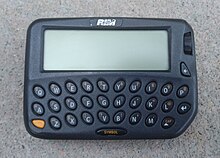BlackBerry 950

BlackBerry 950(introduced as "Inter@ctive Pager 950", development name "Leapfrog" ) is an earlyBlackBerrymodel, introduced in 1998 by CanadiansmartphonemanufacturerResearch in Motion.[1]There were two editions, the Exchange Edition and the Internet Edition, both identical in hardware and differing only in the provided software; the Exchange Edition could connect to corporateemailmailboxes running onMicrosoft Exchange,while the Internet Edition could access generalinternetmailboxes only.[2]
BlackBerry 850 was a different version of this pager, released at later time, which, instead of 900 MHz modem, had an 800 MHz modem that allowed connectivity with theDataTACnetwork.
Specifications
[edit]- Intel 80386EXmicroprocessor[3]
- 4 MBflash memory
- 512 KBSRAM
- 132 x 65 pixel monochrome LCD screen with backlight that could display 6 or 8 lines of text
- oneAA batteryfor power that lasted two weeks.[2]
The pager would beep and vibrate in protest if the battery polarization was reversed when inserted the wrong way.[4] - 134 g (without plastic holster) or 161 g (with plastic holster) weight
- 900 MHz wirelessmodemforMobitexnetwork access
- QWERTYkeyboard and trackwheel
RIM OS
[edit]RIM OS, the operating system designed for those devices, was acooperative multitaskingsystem withmessage passinginfrastructure that depended on the applications to usemessage loopfor processing events from the user interface, in a fashion similar to that of Microsoft Windows.
RIM OS used memory protection provided by the MMU of the 80386EX. Applications were written inC++and compiled into files that followed thePEfile format originally used on Microsoft Windows, which itself was based onCommon Object File Formatthat first appeared on Unix. Those files, that were given the.dllextension, could be inspected with tools that were meant for handling Microsoft Windows executables. Applications, upon beingsideloadedwith BlackBerry Desktop Manager, would be stripped of all the unnecessary data that was included in the.dllfiles, and would belinkedwith the rest of the code on the device allowing themexecute in placefrom the flash memory. The operating system was aware of the layout of the memory, and preserved the names of the files from which applications were loaded, allowing their removal and updating.
RIM, likePalm,would provide strategies to the developers of the applications that would help conserve the scarce resources of the device.[5]
References
[edit]- ^McNish, Jacquie; Silcoff, Sean (2015): Losing he Signal. The Untold Story Behind the Extraordinary Rise and Spectacular Fall of BlackBerry. pp. 50, 64–66.ISBN978-1-250-06017-4.
- ^abStrietelmeier, Julie (February 26, 2001)."RIM BlackBerry 950 Review".The Gadgeteer.
- ^"Research in Motion Itner@ctive 950 Pager".York University Computer Museum, Toronto, Canada.Retrieved30 June2022.
- ^BlackBerry Wireless Handheld Software Version 2.6 Installation and Getting Started Guide.Research in Motion. 21 April 2003.
- ^BlackBerry Software Development Kit Version 2.5 Developer Guide.Research in Motion. 18 July 2002.
